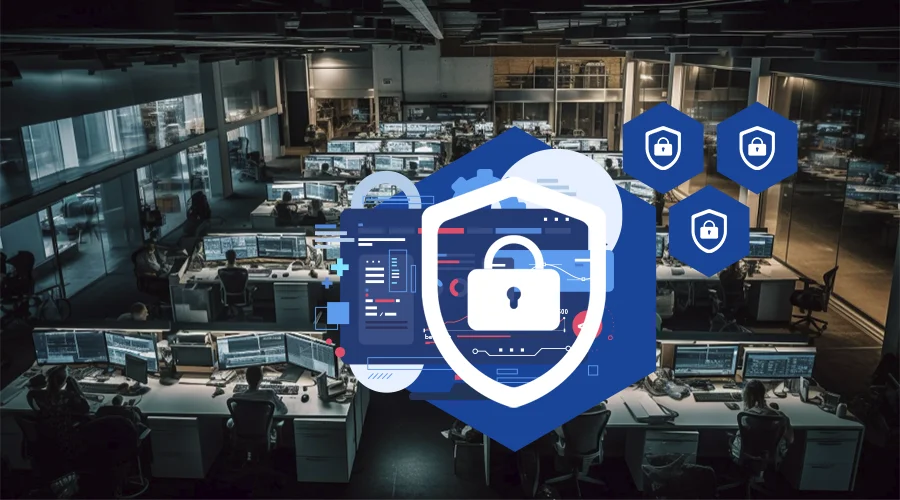Adapting to the Future: The Cybersecurity Mesh Revolution

Cybersecurity Mesh
The old paradigms of cybersecurity are experiencing unprecedented difficulties at a time when digital transformation is changing sectors and corporate environments. The term "Cybersecurity Mesh" has evolved as a ground-breaking idea that addresses the flaws in conventional security architectures and provides a flexible and dynamic method of securing intricate and interconnected digital ecosystems. This article delves into the depths of Cybersecurity Mesh, exploring its architecture, benefits, and applications.
I. What is Cybersecurity Mesh?
Cybersecurity Mesh can be defined as an innovative security approach that shifts away from the traditional perimeter-based security models towards a more flexible and adaptable architecture. Unlike the conventional security strategies that rely heavily on securing the network perimeter, Cybersecurity Mesh focuses on protecting individual entities and resources within an organization's ecosystem. The primary objectives of Cybersecurity Mesh include improving security posture, minimizing security gaps, and fostering a more integrated and collaborative approach to threat response.
Distinct from other security architectures, Cybersecurity Mesh thrives on its decentralized and composable nature. Instead of relying on a single point of control, it emphasizes the zero trust policy, where no entity is inherently trusted, and access is granted based on continuous verification and validation.
II. Cybersecurity Mesh Architecture (CSMA)
At the core of the Cybersecurity Mesh lies the Cybersecurity Mesh Architecture (CSMA), which is a radical departure from the traditional security point solutions. CSMA consists of interconnected layers that work collaboratively to secure the entire digital ecosystem. This architecture addresses the limitations of traditional security tools that often lack interoperability and fail to provide a consolidated and holistic view of the threat landscape.
The standout feature of CSMA is its adaptability to the modern digital landscape. With the rapid evolution of technology and the increasing complexity of IT environments, a static security posture is no longer effective. CSMA allows organizations to create a dynamic and scalable security fabric that can adapt to changing threats and technologies.
III. The 4 Layers of CSMA

Layer 1: Identity and Access Management (IAM)
This layer focuses on robust identity management and access controls. It ensures that only authorized entities can access resources, significantly reducing the risk of unauthorized data breaches.

Layer 2: Threat Detection and Intelligence
Layer 2 involves continuous monitoring and threat detection through advanced analytics. It consolidates threat intelligence from various sources, providing organizations with a comprehensive view of potential threats.

Layer 3: Data Protection and Encryption
Securing data at rest, in transit, and during processing is the core of Layer 3. This layer employs encryption and data protection mechanisms to ensure the confidentiality and integrity of sensitive information.

Layer 4: Response and Recovery
Layer 4 focuses on incident response and recovery. It streamlines the process of identifying, containing, and mitigating security incidents, minimizing their impact on the organization.
IV. Why do businesses need Cybersecurity Mesh?
The web of interconnected devices, networks, services, and data in today's IT environments has led to a surge in security challenges. Organizations struggle to secure their digital assets against cyber threats and attacks. Cybersecurity Mesh offers several benefits in addressing these challenges:

Decentralization
By distributing security functions, Cybersecurity Mesh minimizes the impact of a single point of failure, enhancing the overall resilience of the security.

Adaptability
CSMA's dynamic nature enables organizations to respond swiftly to emerging threats and vulnerabilities, ensuring that security remains effective even in the face of evolving attack vectors.

Collaborative Threat Response
Through distributed intelligence and analytics, Cybersecurity Mesh encourages a collaborative approach to threat detection and mitigation, facilitating a quicker and more comprehensive response.
V. Cybersecurity Mesh and Cloud Security
The synergy between Cybersecurity Mesh and cloud platforms is particularly noteworthy. Cloud environments introduce a unique set of security challenges due to their distributed and dynamic nature. Cybersecurity Mesh aligns perfectly with cloud security by providing a decentralized approach that complements the distributed nature of cloud infrastructure.
CSMA helps address potential vulnerabilities in cloud environments by enabling organizations to establish consistent security policies across hybrid and multi-cloud setups. This ensures that security controls are seamlessly integrated, regardless of the underlying infrastructure.
VI. The Applications

Financial Services: JPMorgan Chase
JPMorgan Chase, a financial giant, employs Cybersecurity Mesh to fortify its security. By distributing threat detection and intelligence, they adapt to dynamic threats and facilitate secure collaboration with partners.

Healthcare: Mayo Clinic
Mayo Clinic secures patient data and medical systems using Cybersecurity Mesh. Robust identity controls, distributed threat monitoring, and encryption ensure patient privacy and compliance.

Technology: Google
Google's extensive services rely on Cybersecurity Mesh for robust protection. Distributed identity management, real-time threat analysis, and advanced data encryption secure user data and maintain trust.

Manufacturing: Siemens
Siemens safeguards industrial control systems with Cybersecurity Mesh. Identity controls, distributed threat monitoring, and proactive incident response ensure operational safety and reliability.
Cybersecurity Mesh implementation resulted in tangible benefits such as greater threat detection and response, improved data security and compliance, enhanced user confidence, and increased system stability. These results highlight Cybersecurity Mesh's significance in providing flexible and effective security solutions.
VII. Cybersecurity Mesh and IT Development
The integration of Cybersecurity Mesh into IT development processes brings substantial advantages. Traditional security architectures often slow down development cycles due to their rigid and centralized nature. In contrast, Cybersecurity Mesh aligns with agile and DevOps methodologies by providing adaptable security controls that can be integrated seamlessly into the development life cycle.
By embedding security considerations early in the development process, organizations can identify and address vulnerabilities at an earlier stage, reducing the cost and effort of addressing security gaps post-development.
VIII. Implementation of Cybersecurity Mesh
Integrating Cybersecurity Mesh into an organization requires a strategic approach:
- Assessment: Begin by assessing your organization's security stance and identifying existing gaps.
- Strategy Development: Develop a comprehensive strategy that outlines how Cybersecurity Mesh will be integrated, including a roadmap for implementation.
- Technology Selection: Choose the appropriate security technologies and solutions that align with the CSMA principles.
- Collaboration: Foster collaboration between IT, security, and development teams to ensure a seamless integration process.
- Training and Education: Provide training to personnel to ensure they understand the new security model and its benefits.
- Testing and Validation: Rigorously test the Cybersecurity Mesh implementation to identify any potential weaknesses or misconfigurations.
- Continuous Improvement: Implement a feedback loop for continuous improvement based on real-world usage and evolving threats.
Challenges and Solutions
While the concept of Cybersecurity Mesh offers numerous benefits, its successful implementation is not without challenges. Addressing these challenges requires careful planning, collaboration, and a deep understanding of the organization's unique requirements.
IX. How Softwarium Can Help
X. FAQ

How can a cybersecurity mesh improve my organization's security?
Cybersecurity Mesh improves security by dispersing security-related tasks, adjusting to evolving threats, encouraging collaborative threat response, and guaranteeing uniform security rules across many contexts.

Who invented cybersecurity mesh?
Although the concept of "Cybersecurity Mesh" has been around for a while, Gartner first used it in its research to underline how revolutionary it may be for security infrastructures.

How will cybersecurity mesh affect organizations in the future?
Cybersecurity Mesh is positioned to become an integral security strategy for businesses. They will be able to better secure their digital ecosystems, stay ahead of evolving threats, and easily incorporate security into their development processes.









